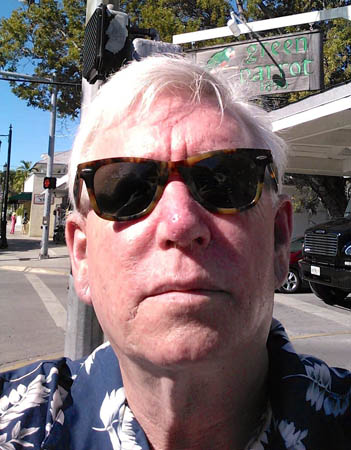
All right- I had to do something productive rather than walk VFR direct downtown to one of the bars I missed and start drinking again. I think Hemingway would have said that, which in its good time led to an exchange with the bartender of the Green Parrot, an establishment that has been dispensing quality liquor from the same spot, Prohibition or no, since 1890.
I liked the place, the more so when one of the more formidable ladies behind the bar brusquely answered the question of a hungry tourist for a menu: “We don’t serve food.”
Remarkably progressive, I thought. But it did not answer a question I had, and I was not hungry.
“Can I ask you something?” I said, addressing the guy who was moving drinks around my corner of the bar. I rested my elbows on the solid bar so I could lean in and ensure I could hear him.
He looked at me with a smile. “You can try.”
I cleared my throat, outlining my thesis. “I just walked up from Hemingway’s House. This is the way he would have gone to get to Sloppy Joe’s, the original and the new one. He must have passed this bar every time he went out for a drink, which is, by my understanding, all the time. Are there any Ernie stories here at the Green Parrot?”
The bartender shook his head, making his long salt-and-pepper ponytail sway across his muscular shoulders. “Nope. Not one. In fact, we used to have a plaque on the wall that said “Neither Earnest Hemingway nor Elvis were ever in this bar. It’s gone now, though.”
“Pity,” I said. He went back to serving the needs of the later afternoon thirsts around the bar, and I mulled the literary problem with a vodka tonic. Could it have been that this was a Navy bar at the time? The Depression-era presence of the service was a powerful force, now largely dissipated with only a few relics left behind. Ernie had been with the ground forces as an ambulance driver in the trenches, after all, and maybe he considered the Swabbies below his notice. This was before his time as a make-belief ASW skipper in his yacht in the Second War, after all. After a few minutes of extra hard thought, my head hurt and I went back to trying to complete my notes about the Parade of Houses.
Scott, Marlow’s personable pal, had mentioned at Solo the other night that his home was a finalist for this Winter’s home show, but the 50-foot tree that had crashed down on his roof made that sort of awkward.
Seeing the first and the last, Houses #1 and #5, had completed the collection in good order. I wish I had done them sequentially, since a nice amount of thought went into what was displayed. House number one was the Eyebrow House, an example from just before the turn of the last century. Wait, I thought. This is starting to get confusing, what with the centuries now seeming to turn on us all the time.
Around the time of the Spanish American War, is what I meant to say, when Uncle Sam’s big footprint was jumping across the Florida Strait and absorbing the Old Spanish Colony of Cuba. Mr. Flagler was in the process of inventing what we know as modern Florida, or maybe better said, he was inventing the one that existed before Miami became the Capital of Latin America.
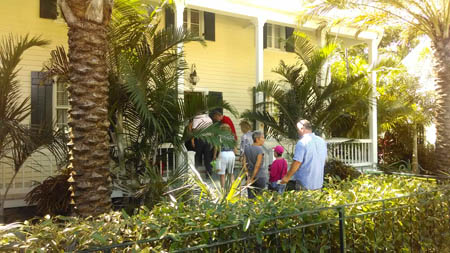
I was trying to process that as I stood in line with the other tourists in front of The Eyebrow House. “This home was built in 1898 in the Classical Revival style. It is unique to Key West, and there are about forty of these homes remaining, either restored or available for restoration. It has a two-story plan with the roof extending down over the second floor windows onto classically-styled porch columns. This restricted the view from the second floor of an Eyebrow, but provided desirable shade, which is now provided by awnings in more recently constructed houses.”
Eyebrow houses. Curious term for architecture, I thought. But the Docent explained the whole thing, something about the roofline being the brow and the upper windows being the eyes. “ This is an indigenous design has had some significant modifications since it was new. Originally, it had a cistern for rainwater catchment, and no running water. Outhouses were located in back. After serving as a winter home for a northern family since 1938, its new owners have continued the tradition of adaptation to the times. The pool area includes a hurricane-rated bathhouse.”
Well, it made sense, I thought. Why would you want to survive a hurricane only to have your bathhouse blown away? Actually, with a little less irony, I found it remarkable that these places had survived more than a century of hurricanes intact. They were doing something right. My pal Boats has an extended narrative about that, as a life-long resident of the Gulf Coast, which I will get to you presently.
The Docent let the people ahead of me enter the house, and talked to me about pineapples. “Henry Flagler’s railroad company began spanning the Keys for a railroad to Key West in 1905. Apparently Mr. Flagler was also interested in a grand agricultural scheme by which his trains running down the Florida Coast would be a steel highway for the ferries to Cuba. The pineapples being grown in Florida at the time were sweet but short, and lacking the rich meat of the version that the Dole boys were raising in another of America’s new possessions, in the Hawaiian islands.
Flagler apparently went out to confer with the Doles, and bought three shiploads of the big pineapples for plantation in Cuba. “Storms wiped them out,” concluded the Docent. I nodded, which seemed to be the only appropriate response.
“Thanks,” I said. “I know people appreciate what you are doing. I am staying over on White Street, across from the Bungalow you are showing as House Number 2. Interesting contrast between that design and this one.”
He nodded. “The big fire in 1923 changed the neighborhood radically. More than forty homes were burned down when the cigar factory burned. The Bungalow and the Victorian at Number 3 were constructed on double or triple lots.” He dig a paper out of his back pocket and handed it over to me to examine. “This is what things looked like.”
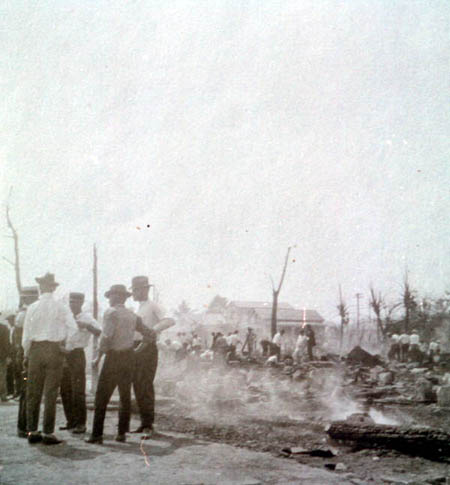
(State Archives of Florida, Florida Memory
I thanked him again, and moved through the house. The renovation again included the removal of non-structural walls to create a large sunny welcoming space with windows that folded out, now that yellow fever is no longer a problem. Upstairs, the eyebrow windows gazed out from two nice little bedrooms with Dade County Pine paneling. The wood had some miraculous qualities- it didn’t rot, was resistant to insects, and was as tough as steel.
It was so good, in fact, that they logged it all off to build Key West in the boom times and there isn’t a stick of it left. Pity- it is beautiful stuff, and panels the apartment where I am hanging my flip-flops at the moment.
I followed along the “watch step” signs on the floor to a lovely garden and sun-drenched pool, and then set off along the alley to the central cemetery fenceline that I followed down to Windsor Lane and House Number 5. I could not help but grin when I saw the brass plaque on the west gate, from a woman named Cheryl Heinlen:
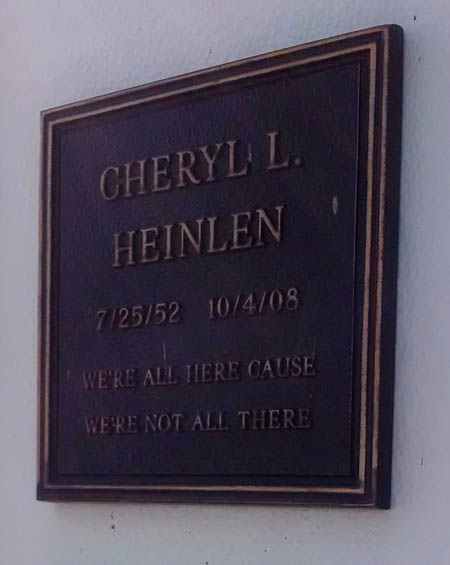
(We’re all here because we’re not all there).
I had to agree with her, and marveled that I was born the year before she was, and had been granted the gift of six more years walking around- perhaps more- than she had. But she seemed to have kept some perspective on it.
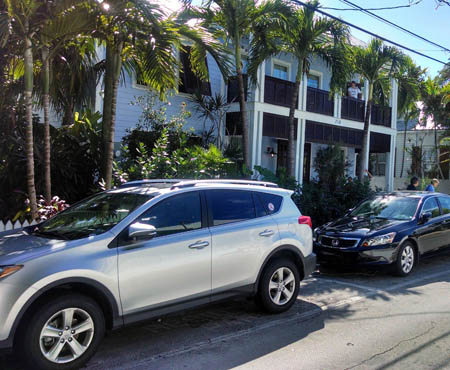
I angled off onto Passover Street to intersect Windsor Lane and could see the commotion up the block in front of the handsome two-story house with the bright metal roof. Very stately, and as the ladies at the card table marked my ticket “complete” I strode up the walk and into the living room of the house. The Docent inside seemed glad to see me, for some unknown reason, and launched immediately into his script, which was amazing. “This tropical modern home was built on a double lot in 2013.”
“You have to be kidding me. It looks like it has been here forever.”
“Nothing is forever,” he said gravely. “But this one was constructed using modular techniques at a plant in Tampa and then shipped down and assembled here. It utilizes energy-efficient, eco-friendly materials that are storm-resistant. The décor, as you will note, is variations in blue.”
“The color is not what surprises me. What does is what you guys have lined out in terms of the architectural evolution of homes on the island. Eyebrow Houses from the Spanish American War, Bungalows from the 1920s, stately Victorians, cigar-roller footprint high-tech little houses, and now this. I can’t believe this is a manufactured home.”
The Docent smiled. “You nailed or scheme. Pretty amazing, isn’t it? Check upstairs. The sitting room between the two suites has flooring that is as close to Dade County Pine as the technology will permit.”
I thanked him, talking to a nice older woman in the kitchen about the faux marble sink and island, and another one on the landing of the steps upstairs that I negotiated carefully.
The views from the decks, north and south, were spectacular.
I followed along the rest of the tour past the ground floor master suite, and joined several other tourists in the master bath, which was beginning to not seem the least bit weird. Eventually I found myself back out by the pool, and my Homes on Parade Tour was complete. I walked back out to he street and was looking at the south-is-north map when a woman asked if she could help me out.
I said, “No, I sort of enjoy being lost. I am trying to transition from architectural tour to literary.”
She nodded in agreement as if that were the most natural thing in the world, and strode off in an island pace. I walked toward Duval, thinking I might follow Hemingway’s ghost for a while, and ask the tough questions at The Green Parrot.
It is five o’clock somewhere, right? I adjusted my Ray Bans and walked into the sunlit street.
Copyright 2014 Vic Socotra
www.vicsocotra.com
Twitter: @jayare303
